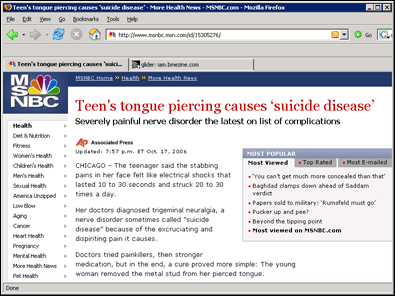|
“Don’t read your press, weigh it.”
Trigeminal Neuralgia and Tongue Piercing… When I got into work on Friday, October 20th, there was a fax waiting for me. It was a copy of a newspaper article from the San Francisco Daily with a headline that read, “Tongue Piercing Tied to Painful ‘Suicide Disease.’” I knew it was going to be a busy weekend. And then the calls started. Had I seen the articles? Had I read them? What was I, as the Medical Liaison for the Association of Professional Piercers, going to do about them? Since the article originated at the Associated Press, it was everywhere. (The AP news service is the oldest and largest news organization in the world. It supplies news to over 1,700 US newspapers daily, 5,000 TV and radio stations, and 8,500 international subscribers.) The piece was printed in dozens of newspapers, occasionally with different headlines over the same body provided by the Associated Press. For those that haven’t seen the article, the gist of it is this: A research letter written up in the Journal of the American Medical Association (JAMA), and published on October 18th, 2006,* was titled “Atypical Trigeminal Neuralgia Associated With Tongue Piercing.” It outlines the case of an Italian woman who complained of face and head pain that started one month after she had her tongue pierced, and lasted for two months until she removed her jewelry. In the article, the pain was purported to come in episodes “described as ‘electric shocks’” which “lasted from 10 to 30 seconds, and recurred 20 to 30 times each day, increasing in frequency and severity in the latter weeks.” According to the authors, these episodes were consistent with the disorder known as trigeminal neuralgia. Trigeminal neuralgia is a condition characterized by sudden attacks of pain involving different sections of the face. These attacks are severe, and are usually described as resembling electric shocks — the pain is intermittent, but intense. And, most importantly, the article goes on to describe several types of trigeminal neuralgia, the main two being typical trigeminal neuralgia, and atypical trigeminal neuralgia. Typical trigeminal neuralgia is incredibly painful, and most often caused by an enlarged blood vessel putting pressure on the trigeminal nerve root (the trigeminal nerve is one of twelve cranial nerves serving the face and head). What results from this pressure is an extreme, electric shock-like pain that is completely debilitating for the sufferer. (The diagnosis of typical TN is based in part upon the sufferer’s description of his/her pain.) Atypical trigeminal neuralgia is a less common form of the disorder and is characterized by less intense, constant, dull burning or aching pain, often with occasional electric shock-like stabs. Atypical TN is also not commonly treatable with medications used for typical TN, such as carbamazapine. (It should be noted that, in the JAMA article, the patient was treated with carbamazapine with little effect.) The woman in the JAMA article was diagnosed with atypical trigeminal neuralgia, based on the descriptions of her pain (and her lack of reaction to the carbamazapine). After the failure of the medication, she took out her tongue piercing jewelry, and the symptoms disappeared completely within 48 hours. Though it was speculated that the tongue piercing was the cause of the TN, it was noted, “The symptom was probably secondary to a lingual metallic implant, and although findings indicate the involvement of the trigeminal system, the location of the piercing and implant should not have resulted in trigeminal injury.” It further references an article in the New England Journal of Medicine, where a 66 year-old woman was suffering from trigeminal neuralgia from a mercury-amalgam filling in one tooth coming in contact with a gold crown on the adjacent one.† On the whole, the research letter in JAMA was informative, well written and, above all, objective. The same cannot be said about the Associated Press article. The problem with the AP article was that it failed to differentiate between typical trigeminal neuralgia and atypical trigeminal neuralgia. It also was the first mention of TN’s most unfortunate nickname: the suicide disease. Because of the overwhelmingly intense pain, those suffering from typical TN have a very high incidence of suicide—the pain is so horrible that many feel this is the only way out. This is not true of atypical TN, which is a much more minor, and more manageable form of the disorder. The combination of these two pieces of the AP article—the lack of distinction between typical and atypical TN, and the inclusion of the phrase “suicide disease”—set the stage for the press that followed. While the title of the AP article—“Tongue Piercing Linked To Pain”—was not especially inflammatory, things got worse each time the article was reprinted. Each news posting (print or web) provided their own headlines, and made decisions about how much of the article to reprint. (Many papers choose to edit the article for length, often leaving out the paragraph where Dr. Marcelo Galarza, an author of the original study, states, “Certainly, this was an isolated case, an extremely rare complication of this kind of piercing,”) This is where the incitive headlines appeared, such as the one MSNBC, which screamed “Teen’s Tongue Piercing Causes ‘Suicide Disease.’” [CACHE] Strangely, the whole incident reminded me of The Simpsons. (Yes, the TV show.) On the first season’s DVD collection, if you listen to the writers’ commentary during the episodes, you hear them often mention the cheap shots and cruel jokes included at the expense of the old. This was because every week they were pitted against the Cosby show in their time bracket. And while The Simpsons led the ratings with the younger demographic, anyone over 40 that was watching TV at that time was watching Bill Cosby and his TV family. This gave the creative team at The Simpsons free rein to make the elderly the butt of any joke they wanted—there was simply no one watching who would complain to the network. This is much the same way piercers and other body modification artists allow themselves to be portrayed by the mainstream media: We’re the whipping boy for traditional news services because not only are we a marginalized and unorganized group, but we’re simply not watching, and not insisting that news outlets are held accountable for misinformation and exaggerations that are printed about us and what we do. So what was I going to do about the mess started by the Associated Press? The first thing I did was to write a letter on behalf of the APP to the Associated Press writer, politely seeking to educate her on the situation, and explaining my interest as the APP’s Medical Liaison. The next, more daunting, task was to attempt to send a letter to the editor of every news outlet that ran the AP article. After emailing out the first round of letters for the articles that were already sent me, I composed a letter to the APP membership asking for help in tracking down versions of the article in all media. This message was sent to every APP member via email asking each to forward me contact info for any paper they encountered which printed the AP story—which quite a few did. (I then sent out the letter to each news source.) This request was also posted on MySpace, and I saw the letter re-posted repeatedly in bulletins by over the course of several days. The response to all this was amazing. I received emails from members (and non-members) from all over the country. These included about fifty links to outlets running the AP letter, from newspapers to TV stations to radio stations to Internet news groups. I spent a day modifying the letter template, and composing and sending a letter to each news editor. I posted on newspaper and newsgroup comment boards, and on larger papers that listed postal addresses, I had letters printed and sent from the APP office to each of the newspapers. At times it did seem rather futile. How many of my letters to the editors did I think would actually get printed? It didn’t matter—I was simply determined to not let tongue piercing be the focus of yet another misinformed, sensationalistic attack on what we do, on what we hold to be most important. And it must have worked. The last time I did a Google search with the words “tongue piercing suicide disease,” my letter came up #3, on the Chicago Tribune’s website [CACHE]. Not too bad. And while we are still a long way, as an industry, from getting the respect that we deserve, we don’t have to be passive participants in the process. If we don’t like the way we’re being portrayed by the mainstream media, we have a responsibility to our industry and ourselves to try to do something about it. Change will be slow to come, but I believe that, unified and organized, we can make a difference. James Weber * Gazzari R, Merceri S, Galarza M. Atypical Trigeminal Neuralgia Associated With Tongue Piercing. Journal of the American Medical Association. Vol. 296, No. 15, October 18, 2006. † Cheshire WP Jr. The Shocking Tooth About Trigeminal Neuralgia. New England Journal of Medicine. 2000;342:2003.
Copyright © The Association of Professional Piercers. Reprinted on BMEzine.com with permission. Articles in this column are published simultaneously in The Point: The Quarterly Journal of the Association of Professional Piercers. Subscriptions are $10 for four issues and are available through the APP website at safepiercing.org. James Weber is the current Medical Liaison for the Association of Professional Piercers. He has been piercing professionally since 1993 and has been actively involved at industry-wide level in legislative, educational, and public relations projects for much of that time. He is the co-owner of Infinite Body Piercing, which he has been operating in Philadelphia since 1995. He is also the editor of The Point: The Quarterly Journal of the Association of Professional Piercers. He can be reached at [email protected].
|


 Started in California in 1994, the
Started in California in 1994, the  BME/News and Modblog highlight only a small fraction of what BME has to offer. Take our free tour and subscribe to BME for access to over 3 million body modification related photos, videos, and stories.
BME/News and Modblog highlight only a small fraction of what BME has to offer. Take our free tour and subscribe to BME for access to over 3 million body modification related photos, videos, and stories.